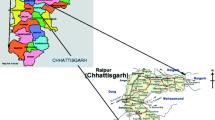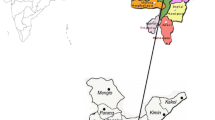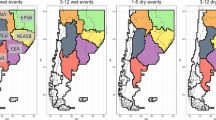Abstract
This study investigates the variability of annual minimum and maximum surface temperature (T min and T max ) of three temperature homogeneous regions [East Coast (EC), Western Coast (WC) and Interior Peninsular (IP)] in southern India in multiple time scales and examines their teleconnections with different climatic indicators. First, the different temperature time series are decomposed into appropriate number of oscillatory modes using the Complete Ensemble Empirical Mode Decomposition with Adaptive Noise (CEEMDAN) algorithm. Subsequently, the modes are subjected to spectral analysis employing the Normalized Hilbert Transform—Direct Quadrature (NHT–DQ) scheme to get instantaneous amplitudes and frequencies. Further, a detailed trend analysis of instantaneous amplitudes is performed, which showed that the recent changes in temperature since 1970s, over southern India are mainly attributed to the increase in amplitudes of the IMFs corresponding to inter-decadal periodicity in all the regions. Moreover, data of four climatic indicators such as Pacific Decadal Oscillation (PDO), Sunspot Number (SN), Total Solar Irradiance (TSI) and CO2 concentration are decomposed using CEEMDAN and compared with decompositions of T max and T min time series of all the three regions. From the cross correlation analysis of oscillatory modes, this study established the links of different climatic indicators with the extreme temperature of southern India, which are evident mainly at few low frequency modes and trend component. The close matching of periodicity of different lower modes of PDO series with that of maximum and minimum temperature of the different regions depicted the possible association of PDO with the temperature regime of southern India. This association is further investigated with a recently developed running correlation analysis method namely Time Dependent Intrinsic Correlation (TDIC), which deciphered a long range positive correlation between the PDO and minimum temperature series at inter annual mode of 7 years to inter decadal mode of 15 years at all the three regions of southern India. The association between PDO and maximum temperature at inter annual ranges is positive at EC and IP regions. The association between PDO and maximum temperature at inter decadal scale show regional differences, with no association at WC region, negative association at IP region and positive association at EC region.












Similar content being viewed by others
References
Abarca-Del-Rio R, Mestre O (2006) Decadal to secular time scales variability in temperature measurements over France. Geophysi Res Lett 33 L13705 doi:10.1029/2006GL026019.
Adarsh (2016) Unveiling the multiscale teleconnection between Pacific Decadal Oscillation and global surface temperature using time dependent intrinsic correlation analysis. Int J Climatol doi:10.1002/joc.4713
Adarsh S, Janga Reddy M (2016a) Analysing the hydroclimatic teleconnections of summer monsoon rainfall in Kerala, India using multivariate empirical mode decomposition and time dependent intrinsic correlation. IEEE Geosci Remote Sens Lett 13(9):1221–1225
Adarsh S, Janga Reddy M (2016b) Multiscale characterization of streamflow and suspended sediment concentration data using Hilbert–Huang transform and time dependent intrinsic correlation analysis. Model Earth Syst Environ 2(4):199 doi:10.1007/s40808-016-0254-z
Anandhi A, Srinivas, VV, Nagesh Kumar D, Nanjundiah RS (2009) Role of predictors in downscaling surface temperature to river basin in India for IPCC SRES scenarios using support vector machine. Int J Climatol 29(4):583–603
Antico A, Schlotthauer G, Torres ME (2014) Analysis of hydro-climatic variability and trends using a novel empirical mode decomposition: application to Parana river basin. J Geophy Res: Atmos 119(3):1218–1233
Autret G, Remy F, Roques S (2013) Multiscale analysis of Antarctic surface temperature series by empirical mode decomposition. J Atmos Ocean Technol 30:649–654
Bai L, Xu J, Chen Z, Li W, Liu Z, Zhao B, Wang Z (2015) The regional features of temperature variation trends over Xinjiang in China by the ensemble empirical mode decomposition method. Int J Climatol 35:3229–3237
Barnhart BL, Eichinger WE (2011a) Analyzing sunspot variability using empirical mode decomposition. Sol Phys 269(2):439–449
Barnhart BL, Eichinger WE (2011b) Empirical Mode Decomposition applied to solar irradiance, global temperature, sunspot number and CO2 concentration data. J Atmos Solar Terr Phys 73:1771–1779
Bedrosian E (1963) A product theorem for Hilbert transforms. Proc IEEE Trans 51:868–869
Capparelli V, Franzke C, Vecchio A, Freeman MP, Watkins NW, Carbone V (2013) A spatiotemporal analysis of US station temperature trends over the last century. J Geophys Res Atmos 118. doi:10.1002/jgrd.50551.
Chen X, Wu Z, Huang NE (2010) The time-dependent intrinsic correlation based on the empirical mode decomposition. Adv Adapt Data Anal 2:233–265
Coughlin KT, Tung KK (2004) 11-year solar cycle in the stratosphere extracted by the empirical mode decomposition method. Adv Space Res 34(2):323–329
Derot J, Schmitt FG, Gentilhomme V, Morin P (2016) Correlation between long term marine temperature time series from eastern and western English channel: Scaling analysis using empirical mode decomposition method. Comptes Rendus Geosc. doi:10.1016/j.crte.2015.12.001
Duffy DG (2004) The application of Hilbert Huang transforms to meteorological datasets. J Atmos Oceanic Tech 21:599–611
Dwivedi S, Mittal AK (2007) Forecasting the duration of active and break spells in intrinsic mode functions of Indian monsoon intra-seasonal oscillations. Geophys Res Lett 34:L16827. doi:10.1029/2007GL030540
Grinsted A, Moore JC, Jevrejeva S (2004) Application of the cross wavelet transform and wavelet coherence to geophysical time series. Nonlin Proc Geophy 11(5/6):561–566
Hamed KH, Rao AR (1998) A modified Mann–Kendall trend test for autocorrelated data. J Hydrol 204:182–196
Hao MA, Qiu X, Lupo, J-P, Gu, P-G, Liu Y-Lu (2015) Analysis of temperature time series based on Hilbert-Huang Transform. J Hydrodyn (Ser B) 27(4):587–592
Hu W, Si BC (2013) Soil water prediction based on its scale-specific control using multivariate empirical mode decomposition. Geoderma 193–194:180–188
Huang Y, Schmitt FG (2014) Time dependent intrinsic correlation analysis of temperature and dissolved oxygen time series using empirical mode decomposition. J Marine Syst 130:90–100
Huang NE, Shen Z, Long SR, Wu MC, Shih HH, Zheng Q, Yen NC, Tung CC, Liu HH (1998) The empirical mode decomposition and the Hilbert spectrum for nonlinear and non-stationary time series analysis. Proc Royal Soc A 454: 903–995
Huang Y, Schmitt FG, Lu Z, Liu Y (2009a) Analysis of daily river flow fluctuations using empirical mode decomposition and arbitrary order Hilbert spectral analysis. J Hydrol 454:103–111
Huang NE, Wu Z, Long SR, Arnold KC, Blank K, Liu TW (2009b) On instantaneous frequency. Adv Adapt Data Anal 1(2):177–229
IPCC (2013) Climate change 2013: the physical science basis. Cambridge University Press, Cambridge, UK
Janga Reddy M, Adarsh S (2016) Time frequency characterization of subdivisional scale seasonal rainfall in India using Hilbert Huang transform. Stoch Envir Res Risk Assess 30(4):1063–1085
Jhajharia D, Singh VP (2011) Trends in temperature, diurnal temperature range and sunshine duration in Northeast India. Int J Climatol 31:1353–1367
Klionski DM, Oreshko NI, Geppener VV, Vasiljev AV (2008) Applications of empirical mode decomposition for processing non-stationary signals. Pattern Recog Image Anal 18(3):390–399
Kothawale DR, Rupa Kumar K (2005) On the recent changes in surface temperature trends over India. Geophys Res Lett 2:L18714. doi:10.1029/2005GL023528
Kothawale DR, Revadekar JV, Rupa Kumar K (2010) Recent trends in pre-monsoon daily temperature extremes over India. J Earth Syst Sci 119(:):51–65
Krishnakumar K, Rupakumar K, Pant GB (1997) Pre-monsoon maximum and minimum temperatures over India in relation to the summer monsoon rainfall. Int J Climatol 17:1115–1127
Kuai KZ, Tsai CW (2012) Identification of varying time scales in sediment transport using the Hilbert–Huang Transform method. J Hydrol 420–421:245–254
Kumari PB, Londhe AL, Daniel S, Jadhav DB (2007) Observational evidence of solar dimming: offsetting surface warming over India. Geophys Res Lett 34. doi:10.1029/2007GL031133
Mantua N J, Hare S R, Zhang Y, Wallace JM, Francis R (1997) A Pacific interdecadal climate oscillation with impacts on salmon production. Bull Am Meteor 78:1069–1079
Massei N, Fournier M (2012) Assessing the expression of large scale climatic fluctuations in the hydrologic variability of daily Seine river flow (France) between 1950–2008 using Hilbert Huang Transform. J Hydrol 448–449(2012):119–128
Nuttall AH (1966) On the quadrature approximation to the Hilbert transform of modulated signals. Proc IEEE 54:1458–1459
Pal I, Al Tabbaa A (2010) Long-term changes and variability of monthly extreme temperatures in India. Theor Appl Climatol 100:45–56
Peel MC, McMahon TA (2006) Recent frequency component changes in interannual climate variability. Geophys Res Lett 33:L16810. doi:10.1029/2006GL025670
Rao AR, Hsu EC (2008) Hilbert–Huang transform analysis of hydrological and environmental time series. Springer Verlag, Netherlands
Rao BBP, Chowdary S, Sandeep VM, Rao VUM, Venkateswarlu B (2014) Rising minimum temperature trends over India in recent decades: Implications for agricultural production. Glob Planet Chang 117:1–8
Rodo X, Rodriguez-Arias MA (2006) A new method to detect transitory signatures and local time/space variability structures in the climate system: the scale-dependent correlation analysis. Clim Dyn 27:441–458
Rupa Kumar K, Krishna Kumar K, Pant GB (1994) Diurnal asymmetry of surface temperature trends over India. Geophys Res Lett 21:677–680
Sonali P, Nagesh Kumar D (2013) Review of trend detection methods and their application to detect temperature change in India. J Hydrol 476(2013):212–227
Tabari H, Marofi S, Aeini A, Talaee PH, Mohammadi K (2011) Trend analysis of reference evapotranspiration in the western half of Iran. Agr Forest Meteorol 151:128–136
Torres ME, Colominas MA, Schlotthauer G, Fladrin P (2011) A complete ensemble empirical mode decomposition with adaptive noise. IEEE International conference on Acoustic Speech and Signal Processing, Prague 22–27 May 2011, pp 4144–4147
Trenberth KE, Fasullo JT (2013) An apparent hiatus in global warming? Earth’s Future 1:19–32
Usoskin IG, Mursula K (2003) Long-term solar cycle evolution: review of recent developments. Solar Phy 218:319–343
Wu Z, Huang NE (2005) Ensemble empirical mode decomposition: a noise-assisted data analysis method. Centre for Ocean-Land-Atmospheric Studies Technical Report. 193, Centre for Ocean-Land-Atmos. Stud., Calverton, Md. 1–51 (ftp://grads.iges.org/pub/ctr/ctr_193.pdf)
Zhang Y, Wallace JM, Battisti DS (1997) ENSO-like interdecadal variability. J Climate 10:1004–1020
Zhen-Shan L, Xian S (2007) Multi-scale analysis of global temperature changes and trend of a drop in temperature in the next 20 years. Meteorol Atmos Phy 95(1–2):115–121
Acknowledgements
The authors offer their special and sincere gratitude to Prof. Francois G. Schmitt, Director, Laboratory of Oceanology and Geosciences (LOG), University of Lille, Wimereux, France, for the scientific discussions on the HHT and TDIC methods held at LOG on October 29, 2014. The authors also acknowledge Prof. Yong-Xiang Huang, Associate Professor in the State Key Laboratory of Marine Environmental Science at Xiamen University, China, for providing the basic source code for TDIC analysis in the MATLAB platform at the website http://zenodo.org/record/9748?ln=en with the intention of promoting non-commercial scientific research.
Author information
Authors and Affiliations
Corresponding author
Rights and permissions
About this article
Cite this article
Adarsh, S., Reddy, M.J. Investigating the multiscale variability and teleconnections of extreme temperature over Southern India using the Hilbert–Huang transform. Model. Earth Syst. Environ. 3, 8 (2017). https://doi.org/10.1007/s40808-017-0281-4
Received:
Accepted:
Published:
DOI: https://doi.org/10.1007/s40808-017-0281-4




